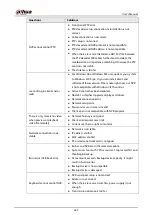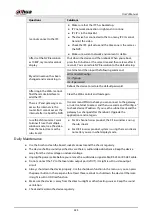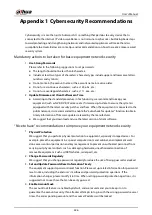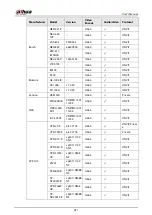
User's Manual
421
6 Glossary
●
DHCP
: DHCP (Dynamic Host Configuration Protocol) is a network protocol. It is one of the TCP/IP
protocol cluster. It is principally used to assign temporary IP addresses to computers on a
network.
●
DDNS
: DDNS (Dynamic Domain Name Server) is a service that maps Internet domain names to IP
addresses. This service is useful to anyone who wants to operate a server (web server, mail server,
ftp server and etc.) connected to the internet with a dynamic IP or to someone who wants to
connect to an office computer or server from a remote location with software.
●
eSATA
: eSATA (External Serial AT) is an interface that provides fast data transfer for external
storage devices. It is the extension specifications of a SATA interface.
●
GPS
: GPS (Global Positioning System) is a satellite system, protected by the US, safely orbiting
thousands of kilometers above the earth.
●
PPPoE
: PPPoE
(
Point to Point Protocol over Ethernet) is a specification for connecting multiple
computer users on an Ethernet local area network to a remote site. Now the popular mode is
ADSL and it adopts PPPoE protocol.
●
Wi-Fi
: Wi-Fi is the name of a popular wireless networking technology that uses radio waves to
provide wireless high-speed Internet and network connections. The standard is for wireless local
area networks (WLANs). It is like a common language that all the devices use to communicate to
each other. It is actually IEEE802.11, a family of standard The IEEE (Institute of Electrical and
Electronics Engineers Inc.)
●
3G
: 3G is the wireless network standard. It is called 3G because it is the third generation of
cellular telecom standards. 3G is a faster network for phone and data transmission and speed Is
over several hundred kbps. Now there are four standards: CDMA2000, WCDMA, TD-SCDMA and
WiMAX.
●
Dual-stream
: The dual-stream technology adopts high-rate bit stream for local HD storage such
as QCIF/CIF/2CIF/DCIF/4CIF encode and one low-rate bit stream for network transmission such as
QCIF/CIF encode. It can balance the local storage and remote network transmission. The dual-
stream can meet the difference band width requirements of the local transmission and the
remote transmission. In this way, the local transmission using high-bit stream can achieve HD
storage and the network transmission adopting low bit stream suitable for the fluency
requirements of the 3G network such as WCDMA, EVDO, TD-SCDMA.
●
On-off value
: It is the non-consecutive signal sampling and output. It includes remote sampling
and remote output. It has two statuses: 1/0.
Summary of Contents for NVR52-16P-4KS2 Series
Page 1: ...Dahua Network Video Recorder User s Manual ZHEJIANG DAHUA VISION TECHNOLOGY CO LTD V1 1 0 ...
Page 74: ...User s Manual 58 Figure 2 79 Alarm input port Figure 2 80 Alarm input port ...
Page 101: ...User s Manual 85 Figure 3 41 Step 9 Secure the HDD bracket and put the top cover back ...
Page 132: ...User s Manual 116 Figure 4 19 Modify IP Step 3 Set parameters See Table 4 5 ...
Page 147: ...User s Manual 131 Figure 4 29 Period Step 3 Set record type See Figure 4 30 ...
Page 452: ...User s Manual ...
















































